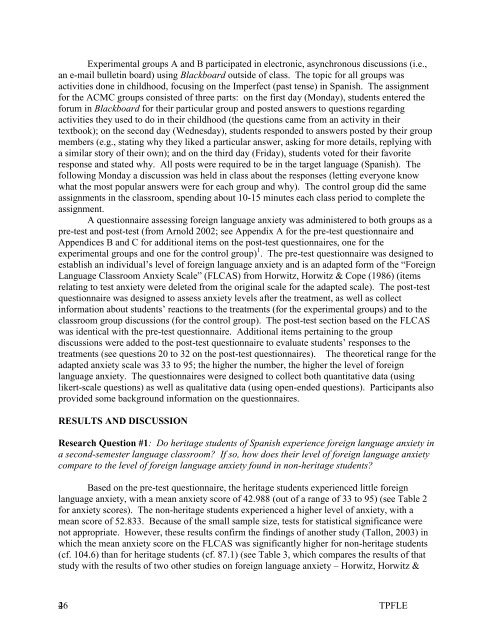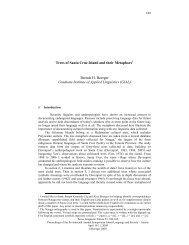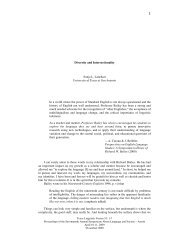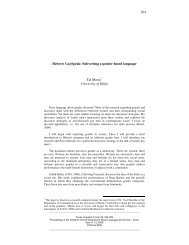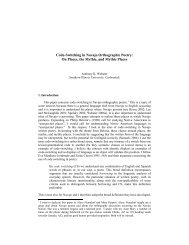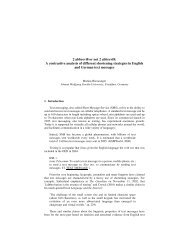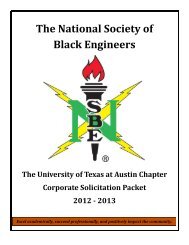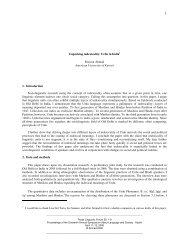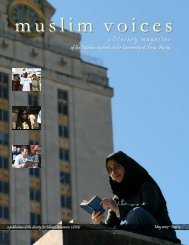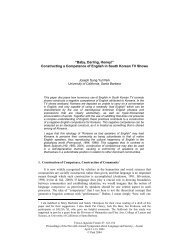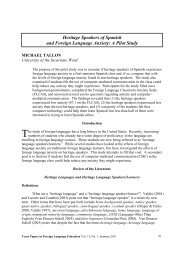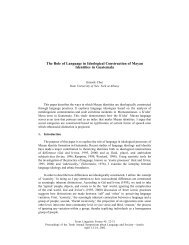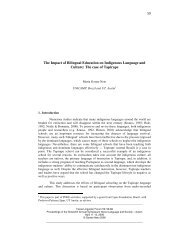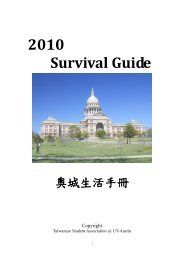The Effects of Computer-Mediated Communication on Foreign ...
The Effects of Computer-Mediated Communication on Foreign ...
The Effects of Computer-Mediated Communication on Foreign ...
Create successful ePaper yourself
Turn your PDF publications into a flip-book with our unique Google optimized e-Paper software.
Experimental groups A and B participated in electr<strong>on</strong>ic, asynchr<strong>on</strong>ous discussi<strong>on</strong>s (i.e.,<br />
an e-mail bulletin board) using Blackboard outside <str<strong>on</strong>g>of</str<strong>on</strong>g> class. <str<strong>on</strong>g>The</str<strong>on</strong>g> topic for all groups was<br />
activities d<strong>on</strong>e in childhood, focusing <strong>on</strong> the Imperfect (past tense) in Spanish. <str<strong>on</strong>g>The</str<strong>on</strong>g> assignment<br />
for the ACMC groups c<strong>on</strong>sisted <str<strong>on</strong>g>of</str<strong>on</strong>g> three parts: <strong>on</strong> the first day (M<strong>on</strong>day), students entered the<br />
forum in Blackboard for their particular group and posted answers to questi<strong>on</strong>s regarding<br />
activities they used to do in their childhood (the questi<strong>on</strong>s came from an activity in their<br />
textbook); <strong>on</strong> the sec<strong>on</strong>d day (Wednesday), students resp<strong>on</strong>ded to answers posted by their group<br />
members (e.g., stating why they liked a particular answer, asking for more details, replying with<br />
a similar story <str<strong>on</strong>g>of</str<strong>on</strong>g> their own); and <strong>on</strong> the third day (Friday), students voted for their favorite<br />
resp<strong>on</strong>se and stated why. All posts were required to be in the target language (Spanish). <str<strong>on</strong>g>The</str<strong>on</strong>g><br />
following M<strong>on</strong>day a discussi<strong>on</strong> was held in class about the resp<strong>on</strong>ses (letting every<strong>on</strong>e know<br />
what the most popular answers were for each group and why). <str<strong>on</strong>g>The</str<strong>on</strong>g> c<strong>on</strong>trol group did the same<br />
assignments in the classroom, spending about 10-15 minutes each class period to complete the<br />
assignment.<br />
A questi<strong>on</strong>naire assessing foreign language anxiety was administered to both groups as a<br />
pre-test and post-test (from Arnold 2002; see Appendix A for the pre-test questi<strong>on</strong>naire and<br />
Appendices B and C for additi<strong>on</strong>al items <strong>on</strong> the post-test questi<strong>on</strong>naires, <strong>on</strong>e for the<br />
experimental groups and <strong>on</strong>e for the c<strong>on</strong>trol group) 1 . <str<strong>on</strong>g>The</str<strong>on</strong>g> pre-test questi<strong>on</strong>naire was designed to<br />
establish an individual‟s level <str<strong>on</strong>g>of</str<strong>on</strong>g> foreign language anxiety and is an adapted form <str<strong>on</strong>g>of</str<strong>on</strong>g> the “<strong>Foreign</strong><br />
Language Classroom Anxiety Scale” (FLCAS) from Horwitz, Horwitz & Cope (1986) (items<br />
relating to test anxiety were deleted from the original scale for the adapted scale). <str<strong>on</strong>g>The</str<strong>on</strong>g> post-test<br />
questi<strong>on</strong>naire was designed to assess anxiety levels after the treatment, as well as collect<br />
informati<strong>on</strong> about students‟ reacti<strong>on</strong>s to the treatments (for the experimental groups) and to the<br />
classroom group discussi<strong>on</strong>s (for the c<strong>on</strong>trol group). <str<strong>on</strong>g>The</str<strong>on</strong>g> post-test secti<strong>on</strong> based <strong>on</strong> the FLCAS<br />
was identical with the pre-test questi<strong>on</strong>naire. Additi<strong>on</strong>al items pertaining to the group<br />
discussi<strong>on</strong>s were added to the post-test questi<strong>on</strong>naire to evaluate students‟ resp<strong>on</strong>ses to the<br />
treatments (see questi<strong>on</strong>s 20 to 32 <strong>on</strong> the post-test questi<strong>on</strong>naires). <str<strong>on</strong>g>The</str<strong>on</strong>g> theoretical range for the<br />
adapted anxiety scale was 33 to 95; the higher the number, the higher the level <str<strong>on</strong>g>of</str<strong>on</strong>g> foreign<br />
language anxiety. <str<strong>on</strong>g>The</str<strong>on</strong>g> questi<strong>on</strong>naires were designed to collect both quantitative data (using<br />
likert-scale questi<strong>on</strong>s) as well as qualitative data (using open-ended questi<strong>on</strong>s). Participants also<br />
provided some background informati<strong>on</strong> <strong>on</strong> the questi<strong>on</strong>naires.<br />
RESULTS AND DISCUSSION<br />
Research Questi<strong>on</strong> #1: Do heritage students <str<strong>on</strong>g>of</str<strong>on</strong>g> Spanish experience foreign language anxiety in<br />
a sec<strong>on</strong>d-semester language classroom? If so, how does their level <str<strong>on</strong>g>of</str<strong>on</strong>g> foreign language anxiety<br />
compare to the level <str<strong>on</strong>g>of</str<strong>on</strong>g> foreign language anxiety found in n<strong>on</strong>-heritage students?<br />
Based <strong>on</strong> the pre-test questi<strong>on</strong>naire, the heritage students experienced little foreign<br />
language anxiety, with a mean anxiety score <str<strong>on</strong>g>of</str<strong>on</strong>g> 42.988 (out <str<strong>on</strong>g>of</str<strong>on</strong>g> a range <str<strong>on</strong>g>of</str<strong>on</strong>g> 33 to 95) (see Table 2<br />
for anxiety scores). <str<strong>on</strong>g>The</str<strong>on</strong>g> n<strong>on</strong>-heritage students experienced a higher level <str<strong>on</strong>g>of</str<strong>on</strong>g> anxiety, with a<br />
mean score <str<strong>on</strong>g>of</str<strong>on</strong>g> 52.833. Because <str<strong>on</strong>g>of</str<strong>on</strong>g> the small sample size, tests for statistical significance were<br />
not appropriate. However, these results c<strong>on</strong>firm the findings <str<strong>on</strong>g>of</str<strong>on</strong>g> another study (Tall<strong>on</strong>, 2003) in<br />
which the mean anxiety score <strong>on</strong> the FLCAS was significantly higher for n<strong>on</strong>-heritage students<br />
(cf. 104.6) than for heritage students (cf. 87.1) (see Table 3, which compares the results <str<strong>on</strong>g>of</str<strong>on</strong>g> that<br />
study with the results <str<strong>on</strong>g>of</str<strong>on</strong>g> two other studies <strong>on</strong> foreign language anxiety – Horwitz, Horwitz &<br />
2 46<br />
TPFLE


